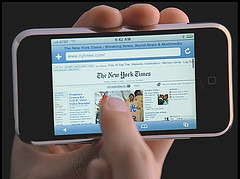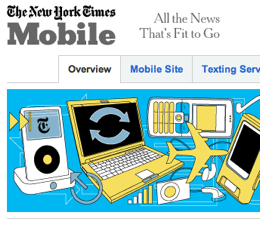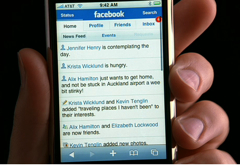
From time to time, I’ll give an overview of one broad MediaShift topic, annotated with online resources and plenty of tips. The idea is to help you understand the topic, learn the jargon, and take action. I’ve already covered blogging, citizen journalism, hyper-local news and other topics. This week I’ll look at the mobile web.
Background
The mobile web, or mobile Internet, is the experience of browsing the Net or using Internet functionality such as online maps and web search on your cellular phone or personal digital assistant (PDA). The promise of the mobile web is to let you do things like check email or news headlines, find good local restaurants, and get driving directions while you are on the move.
While mobile web applications have been around since the late ’90s — including a pioneering effort by the Weather Underground and AT&T in 1997 — the promise of the technology has far outstripped reality. One major problem is a lack of technical standards, causing some web services to work on some phones but not others. Plus, many websites are difficult to navigate or view correctly from mobile devices.
A slide from a World Wide Web Consortium (W3C) presentation sums up a typical user experience with the mobile web:
> While commuting to work, user sees a URL on a billboard.
> “Hey — I’ve just bought a snazzy new phone with access to ‘the Web,’ right? I’ll give it a try!”
> Works for 15 minutes to figure out how to enter a URL into their phone’s browser.
> Seems to load something, but logos and images are so huge that it’s impossible to make sense of the user interface on the small phone screen.
> Tries to log in to favorite web mail system.
> “Sorry, your browser doesn’t support cookies!”
> Throws phone out train window.
And as mobile screen sizes get bigger, and data services get speedier, the mobile web experience will improve. The launch of the iPhone last summer, with its big touch screen and simple zoom feature, has driven use of the mobile web in the U.S. higher — which, in turn, motivates iPhone competitors to innovate even more. Plus, Google has pushed mobile handset makers and cell carriers to consider open standards for software and more interoperability so phones can work on multiple carriers.
Challenges for Media
Media companies want to get their content to people no matter where they are or what device they are using, so it’s no surprise that newspapers, TV networks and major news sites have offered up mobile services for years, providing mobile users with news articles, videos, weather reports and more. But in order to get that info to people, the media companies either need to make a content deal with the cell phone carrier — such as Sprint Nextel or Verizon — or create a special website that’s optimized for mobile web browsing.

The New York Times, for instance, has a mobile site at mobile.nytimes.com that include blogs, weather reports, stock reports and more — all designed for the smaller mobile screen. Plus, the Times has a texting service that will send you headlines or even real estate listings to your phone via text messaging.
(See MediaShift associate editor Jennifer Woodard Maderazo’s take on her bad experience with the mobile web.)
It turns out that newspapers are doing more to reach out to mobile users than bloggers are. The Bivings Group, a Washington DC-based Internet communications firm, did a survey last year of the top 50 newspaper sites and the top 50 blogs to see who offered up sites specialized for mobile phones. The newspapers trumped the blogs with 54% of sites offering a mobile browsing experience, while only 24% of the top blogs offered that.
In general, a lack of standards can make for a frustrating mobile experience. “I discovered that there was much inconsistency in the format and URLs of mobile sites,” wrote Erin Teeling of the Bivings Group. “The lack of standardized ways of dealing with mobile content creates real frustrations for mobile users.”
Just how frustrating can it get for users? Check out this mobile page for a local TV station, KVBC in Las Vegas. You have to choose the wireless service provider you have, and then pay $2.99 to $4.99 per month to get news and video from the local station onto your phone. And getting rid of the service is even more of a pain; there’s a nine-step process outlined for quitting the AT&T version of the service on the station’s FAQ page.
The problem for media companies is that users are accustomed to getting content free on the web, and don’t want to have to pay more for mobile content — or download a special mobile browser to view it. We want the process to be smooth, easy to find and set up, and consistent from device to device. And that’s rarely what we get.
The iPhone Changes Everything
With all these hurdles, it seemed like the mobile web had a long way to go to reach mainstream usage in the U.S.
But last year, when Apple unleashed its iPhone, the company delivered the mobile web experience people were waiting for. The screen was bigger, and users could zoom in on web pages and navigate much easier than on the typical smartphone. “A recent survey by M:Metrics”: http://www.mmetrics.com/press/PressRelease.aspx?article=20080318-iphonehype showed that iPhone users are far out ahead of other smartphone users in mobile web use, especially in getting news and watching video.

For January 2008, M:Metrics found that 84.8% of iPhone users got news or info from a mobile browser vs. 58.2% on all smartphones or 13.1% on all mobile phones. Plus, 58.6% of iPhone users did web searches vs. 37% of smartphone users; and 30.9% of iPhone users watched mobile TV vs. 14.2% of smartphone users. And sites such as Facebook that are optimized especially for the iPhone performed even better: 20% of iPhone users accessed Facebook on their phone, while only 1.5% of all cell phone users did.
What’s amazing is how profound an effect the iPhone and its phone-free cousin the iPod Touch have had on the mobile web market in such a brief time frame. Over the past three months, StatCounter found that the mobile Safari browser that’s in the iPhone was the most popular mobile web browser used in the U.S. and No. 2 mobile browser in the world.
Of course, not everyone believes that the iPhone’s finger-tapping interface is the best one for mobile web surfing. While Forrester Research found that the iPhone’s mobile web experience topped the competition by bringing full-featured websites to mobile phones, blogging pioneer Dave Winer begged to differ, writing on his blog:
The iPhone view of the web is not optimal for the user. Given a choice between a site well-designed for mobile use, and the extra work you have to do to zoom in and out and scroll in all directions to read a page laid out for a big screen on a tiny one, there’s no choice at all, I’ll go with the one designed for mobile use.
Still, the iPhone and its various look-alikes will only get better over time, with speedier connections on third-generation wireless networks, bigger screens and a mobile web experience that will look more and more like the web on a full-size computer. Plus, cell carriers are starting to offer more “all-you-can-eat” data plans, which offer unlimited mobile web browsing — breaking down another barrier to more widespread mobile usage in the U.S.
Open Systems and Beyond
Another recent trend might also transform the experience of the mobile web: Google’s push for open wireless networks. In the FCC’s recently completed auction for the 700MHz spectrum — which would allow the winning bidder to offer powerful wireless Internet nationwide — Google lobbied the commission to require that network to be open to any device or software. The FCC agreed to the requirement, and Verizon Wireless announced it would open its own wireless network as well to any handset maker. AT&T later followed suit with its own open network initiative, and Google unveiled its Android cell phone software that would work with any hardware.
What does this all mean for the mobile web? If networks are open, mobile phones can work on more networks, and software is more interoperable, which means that consumers will have more choices and more options for carriers and services. So if there is innovation with a mobile web browser, it won’t be limited to one handset working on one network — it will more easily spread over various carriers so that everyone can reap the new innovation.

There’s been a fundamental problem for people trying to innovate with the mobile web: the closed approach of cell carriers. Michael Mace, a former executive at Palm, explains how the culture of the mobile industry has clashed with the culture of tech compaines in Silicon Valley:
The mobile phone industry is notorious for trying to create ‘walled gardens,’ tightly controlled collections of content and services for which they charge substantial fees. They tend to put obstacles in the way of open, unlimited access to the Internet, and are much slower to enable new services than web companies are. I’ve had some mobile software developers tell me they were forced out of business because their funding ran out before the operators gave them permission to operate.
There are sometimes good reasons for the operators’ caution — they’ve been burned by a lot of failed data services, and they’re afraid rogue software might somehow attack and destroy their networks. But the feeling among many tech companies is that the operators are using this as an excuse rather than actually trying to solve the problems…
That attitude, in which the operator does the thinking for the customer, is incredibly uncomfortable to most Silicon Valley companies. They are used to selling directly to end users, and don’t want to work through anyone else. They want the operators to be neutral providers of all products and services, enabling customers to make their own product decisions. That’s the way the wired Internet works, and Silicon Valley wants the same thing in wireless.
The mobile Internet is only in its infancy, and the possibility of more open approaches could mean better and more reasonably priced services. And we only have to look to Japan to see how the mobile Internet could transform our culture. Last April, Japan’s Video Research Interactive found that 54% of Japanese cell phone users accessed the Net from their phone in the last week, up from 40% in 2006. And young schoolgirls were leading the way, with 84% of 12- to 19-year-old girls using the mobile web in a typical week last year.
Resources
To learn more about the mobile Internet, check out these websites, articles and blogs.
Asian Mobile Web Years Ahead at ReadWriteWeb
Content issues on tap at wireless confab by Hollywood Reporter
History of Mobile Phones entry at Wikipedia
I Remember When Spam Came in a Can; Now It’s in my Cell Phone at Bivings Report
In Pictures — A History of Cell Phones at PC World
Japanese mobile phone culture entry at Wikipedia
Mobile Internet boom imminent, study says at Computerworld
Mobile Opportunity blog
Mobile TV’s Looking Like a Big Turnoff at Media Life
Nokia 888 Concept Phone on YouTube
Nokia Morph Concept Phone on YouTube
Putting customers to work, Nokia takes on the Web on the Guardian
So why has mobile Internet taken off in Asia at the Mobile Marketing & Spam blog
VON: Low-power devices, true Internet access to drive mobile usage at Telephony Online
*****
What do you think about the mobile web experience? Do you access the Internet on your cell phone — why or why not? What features would you like to see in future mobile web services? Share your thoughts in the comments below.
Photo of iPhone commercial by Rocky Agrawal via Flickr.

Hi Mark — interesting piece.
About whether or not iPhones require mobile versions of websites, I think the jury is in on that one, as more and more sites produce iPhone-friendly versions of their sites.
For example, I now use GMail instead of the iPhone’s native mail app. It works the way I like to work, and I use GMail from my desktop and laptop, but when I access it from the iPhone I use the special iPhone version of GMail, until that existed, GMail was fairly nonfunctional on the iPhone, imho.